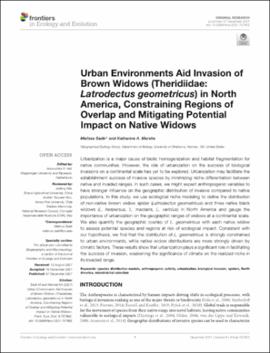| dc.contributor.author | Sadir, Melissa | |
| dc.contributor.author | Marske, Katharine A. | |
| dc.date.accessioned | 2022-02-21T21:26:53Z | |
| dc.date.available | 2022-02-21T21:26:53Z | |
| dc.date.issued | 2021-12-07 | |
| dc.identifier.citation | Sadir M and Marske KA (2021) Urban Environments Aid Invasion of Brown Widows (Theridiidae: Latrodectus geometricus) in North America, Constraining Regions of Overlap and Mitigating Potential Impact on Native Widows. Front. Ecol. Evol. 9:757902. doi: 10.3389/fevo.2021.757902 | en_US |
| dc.identifier.uri | https://hdl.handle.net/11244/334653 | |
| dc.description.abstract | Urbanization is a major cause of biotic homogenization and habitat fragmentation for native communities. However, the role of urbanization on the success of biological invasions on a continental scale has yet to be explored. Urbanization may facilitate the establishment success of invasive species by minimizing niche differentiation between native and invaded ranges. In such cases, we might expect anthropogenic variables to have stronger influence on the geographic distribution of invasive compared to native populations. In this study, we use ecological niche modeling to define the distribution of non-native brown widow spider (Latrodectus geometricus) and three native black widows (L. hespersus, L. mactans, L. variolus) in North America and gauge the importance of urbanization on the geographic ranges of widows at a continental scale. We also quantify the geographic overlap of L. geometricus with each native widow to assess potential species and regions at risk of ecological impact. Consistent with our hypothesis, we find that the distribution of L. geometricus is strongly constrained to urban environments, while native widow distributions are more strongly driven by climatic factors. These results show that urbanization plays a significant role in facilitating the success of invasion, weakening the significance of climate on the realized niche in its invaded range. | en_US |
| dc.description.sponsorship | This research was supported by funding from the OU Graduate Adams Research Scholarship. Open Access fees paid for in whole or in part by the University of Oklahoma Libraries. | en_US |
| dc.language | en_US | en_US |
| dc.rights | Attribution 4.0 International | * |
| dc.rights.uri | https://creativecommons.org/licenses/by/4.0/ | * |
| dc.subject | Species distribution models | en_US |
| dc.subject | Anthropogenic activity | en_US |
| dc.subject | Urbanization | en_US |
| dc.subject | Biological invasion | en_US |
| dc.subject | Spiders | en_US |
| dc.subject | North America | en_US |
| dc.subject | Microhabitat selection | en_US |
| dc.title | Urban Environments Aid Invasion of Brown Widows (Theridiidae: Latrodectus geometricus) in North America, Constraining Regions of Overlap and Mitigating Potential Impact on Native Widows | en_US |
| dc.type | Article | en_US |
| dc.description.peerreview | Yes | en_US |
| dc.identifier.doi | 10.3389/fevo.2021.757902 | en_US |
| ou.group | Dodge Family College of Arts and Sciences::Department of Biology | en_US |

